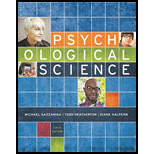
a.
To match:
An end-of-semester course evaluation that asks students to rate the class.
Introduction:
Assessing an issue based on surveying the population and their feedback is a qualitative experimental approach. In many of the statistical and experimental research survey method gives the quality and nature of a group, based on the participant’s feedback.
b.
To determine:
Collection of data showing that on average, students who studied more hours for a psychology examination earned higher grades.
Introduction:
Studying more and concentrating in studies help the students to achieve more in their exams. Studying makes the student to acquire more subject knowledge and can perform well in exams.
c.
To determine:
A study comparing the driving performance between people randomly assigned to text while driving or to drive without distractions.
Introduction:
Using mobile phones while driving is a legal violation in many countries. Mobile phone usage leads to distractions and cause motor accidents every year in high rate.
d.
To determine:
A research report describing a person with an extremely rare psychological disorder.
Introduction:
Case study is observing a peculiar thing and doing research on a confined matter. Case study is mostly done in medical fields with patients in health disorders.
e.
To determine:
A study comparing voting preferences for people in wealthy neighborhoods compared to people in middle-class neighborhoods.
Introduction:
Voting is a social rights of every humans. Voting system is used to elect a person based on the people desire in a society.
f.
To determine:
A study describing how 8-year-old children interacted on their school playground.
Introduction:
Children’s like to play much rather than any social activities. They are more attentive and enthusiastic while playing than any other activities because of its gives them enthusiasm.
g.
To determine:
A study comparing tumor size in three groups of mice, each given a different dose of nicotine.
Introduction:
Smoking is a serious injurious to health. It causes lung cancer and other ailments. Any sort of tobacco product usage may leads to serious health concerns. Nicotine a chemical compound in tobacco causes cancer.
h.
To determine:
A study comparing the rate of cancer in people who are nonsmokers, light smokers, or heavy smokers.
Introduction:
Smoking is a serious injurious to health. It causes lung cancer and other ailments. Any sort of tobacco product usage may leads to serious health concerns.
Want to see the full answer?
Check out a sample textbook solution
Chapter 2 Solutions
Psychological Science (Fifth Edition)
- Identify applicable scenarios and examples observed ‘in action’ during your class behavior. Provide an analysis of psychological theory, themes, and concepts evident in the work observed during class. What theoretical framework is used to understand/explain what occurred in your experiences?arrow_forwardwhat makes the candomble tradition stand out?arrow_forwardby observing behavior students in class , what your thoughts about the effectiveness and purpose of the work being done there?arrow_forward
- When would using checklists and rating scales be most appropriate in early childhood? Use scholarly sources.arrow_forwardI need help with two articles are there any similarities and differences between the two https://www.phnompenhpost.com/business/indian-ambassador-pledges-increased-trade-tourismpromotion, https://time.com/5486460/pol-pot-cambodia-1979/arrow_forwardEvaluate the application of behaviourism and cognitive psychological perspectives to contemporary issues in psychology.arrow_forward
- Analyse the similarities and the differences between behaviourism and cogniperspectives in psychology.arrow_forwardEvaluate the work of key theorists Neisser, 1967 relating to congnitive psychological perspectivearrow_forwardEvaluate the work of key theorists John B. Watson and B.F. Skinner relating to behaviourismarrow_forward
 Ciccarelli: Psychology_5 (5th Edition)PsychologyISBN:9780134477961Author:Saundra K. Ciccarelli, J. Noland WhitePublisher:PEARSON
Ciccarelli: Psychology_5 (5th Edition)PsychologyISBN:9780134477961Author:Saundra K. Ciccarelli, J. Noland WhitePublisher:PEARSON Cognitive PsychologyPsychologyISBN:9781337408271Author:Goldstein, E. Bruce.Publisher:Cengage Learning,
Cognitive PsychologyPsychologyISBN:9781337408271Author:Goldstein, E. Bruce.Publisher:Cengage Learning, Introduction to Psychology: Gateways to Mind and ...PsychologyISBN:9781337565691Author:Dennis Coon, John O. Mitterer, Tanya S. MartiniPublisher:Cengage Learning
Introduction to Psychology: Gateways to Mind and ...PsychologyISBN:9781337565691Author:Dennis Coon, John O. Mitterer, Tanya S. MartiniPublisher:Cengage Learning Psychology in Your Life (Second Edition)PsychologyISBN:9780393265156Author:Sarah Grison, Michael GazzanigaPublisher:W. W. Norton & Company
Psychology in Your Life (Second Edition)PsychologyISBN:9780393265156Author:Sarah Grison, Michael GazzanigaPublisher:W. W. Norton & Company Cognitive Psychology: Connecting Mind, Research a...PsychologyISBN:9781285763880Author:E. Bruce GoldsteinPublisher:Cengage Learning
Cognitive Psychology: Connecting Mind, Research a...PsychologyISBN:9781285763880Author:E. Bruce GoldsteinPublisher:Cengage Learning Theories of Personality (MindTap Course List)PsychologyISBN:9781305652958Author:Duane P. Schultz, Sydney Ellen SchultzPublisher:Cengage Learning
Theories of Personality (MindTap Course List)PsychologyISBN:9781305652958Author:Duane P. Schultz, Sydney Ellen SchultzPublisher:Cengage Learning





